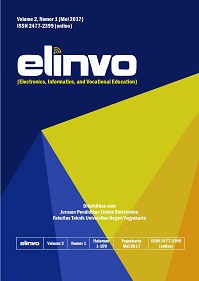Kinerja dari Prototipe Robot Visual Pengumpul Sampah Perairan dengan Remote Control menggunakan Telemetri
DOI:
https://doi.org/10.21831/elinvo.v4i1.28343Keywords:
Remote Control, First Person Viewer, Prototype, Water Garbage Collection RobotAbstract
References
Asia and M. Z. Arifin, "Dampak Sampah Plastik bagi Ekosistem Laut," Bul. Matric, vol. 14, no. 1, pp. 44–48, 2017.
J. R. Jambeck, R. Geyer, C. Wilcox, T. R. Siegler, M. Perryman, A. Andrady, R. Narayan, and K. L. Law, "Plastic waste inputs from land intothe ocean," Science (80-. )., vol. 347, no. 6223, pp. 768–771, 2015.
L. Jemadu, "LIPI: Tiap 1 Meter Persegi Pantai Indonesia, Ada 1,7 Sampah Plastik," Suara.com, 2018. [Online]. Available: https://www.suara.com/tekno/2018/11/30/173952/lipi-tiap-1-meter-persegi-pantai-indonesia-ada-17-sampah-plastik.
K. L. Law and R. C. Thompson, "Microplastics in the seas," Science (80-. )., vol. 345, no. 6193, pp. 144–145, 2014.
A. Lusher, M. McHugh, and R. Thompson, "Occurrence of microplastics in the gastrointestinal tract of pelagic and demersal fish from the English Channe," Mar. Pollut. Bull., vol. 67, pp. 94–99, 2013.
S. A. Carr, J. Liu, and A. G. Tesoro, "Transport and fate of microplastic particles in wastewater treatment plants," Water Res, vol. 91, pp. 174–182, 2016.
G. L. Widyaningrum, "Perilaku Manusia dan Dampak Sampah Plastik yang Menewaskan Hewan Laut," National Geographic Indonesia, 2018. [Online]. Available: https://nationalgeographic.grid.id/read/131244353/perilaku-manusia-dan-dampak-sampah-plastik-yang-menewaskan-hewan-laut?page=all.
K. S. N. RI, Peraturan Presiden (PERPRES) Nomor 97 Tahun 2017 tentang Kebijakan dan Strategi Nasional Pengelolaan Sampah Rumah Tangga dan Sampah Sejenis Sampah Rumah Tangga. 2017.
F. Irawan and A. Yulianto, "Perancangan Prototype Robot Observasi Bawah Air dan Kontrol Hovering Menggunakan Metode Pid Control," J. Sains dan Inform., vol. 1, no. 1, pp. 63–70, 2015.
M. Iqbal, "Remote Control Rescue Robotic Boat for Search Operation," Int. J. Comput. Eng. Inf. Technol., vol. 8, no. 6, pp. 96–99, 2016.
B. L. H. D. I. Yogyakarta, Dokumen Informasi Kinerja Pengelolaan Lingkungan Hidup Daerah Istimewa Yogyakarta (DIY). Yogyakarta: BLH DIY, 2016.
Downloads
Published
How to Cite
Issue
Section
Citation Check
License
The article published in ELINVO became ELINVO's right in publication.
This work by ELINVO is licensed under a Creative Commons Attribution-NonCommercial 4.0 International License.









